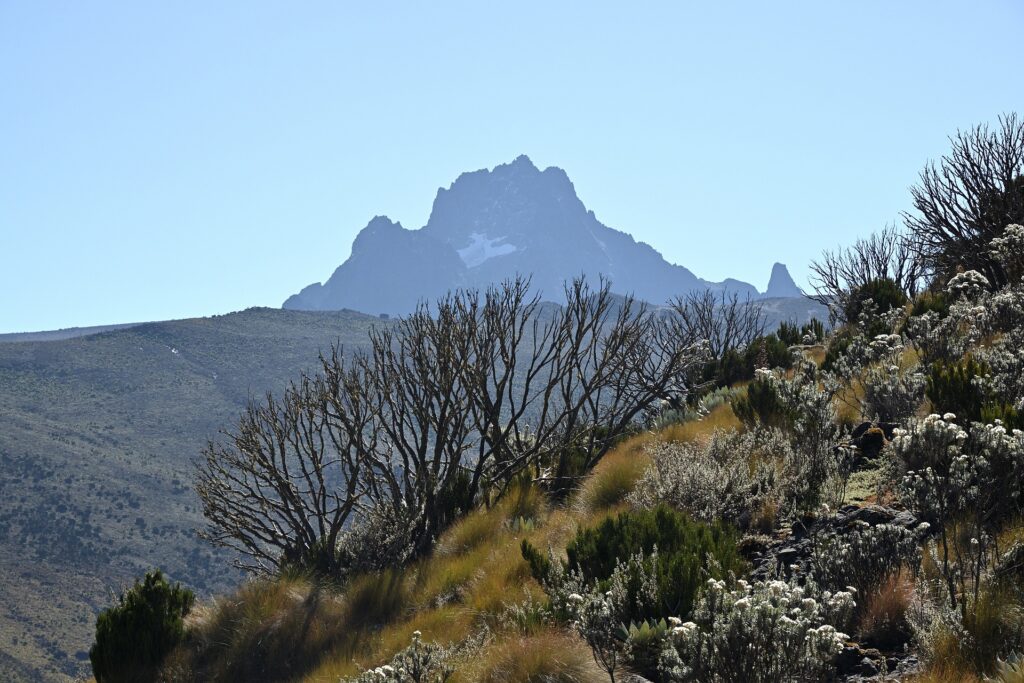
6 Days Mt Kenya Climbing: Sirimon – Naro Moru With Peak Circuit Route
Sirimon Route
starts 15 km (9 miles) east around the Mount Kenya Ring Road from Nanyuki. The gate is 10 km (6 miles) further along the track, which can be walked or driven by two-wheel drives.
The track climbs up through the forest. On the north side of the mountain there is no bamboo zone, so the forest gradually turns into moorland covered with giant heather. The track ends at Old Moses Hut and becomes a path. This continues up the hill before splitting into two routes. To the left, the least used path goes around the side of the Barrow, to Liki North Hut. The vegetation becomes more sparse, with giant lobelia and groundsels dotted around. The path climbs over a ridge, before rejoining the main path ascending the Mackinder Valley. Shipton’s Cave can be found in the rock wall to the left of the steep path just before reaching Shipton’s Camp.
From Shipton’s Camp, it is possible to ascend the ridge directly in front of the camp to the site of Kami Hut, which no longer exists, or follow the river up to Lower Simba Tarn and eventually to Simba Col. These are both on the Peak Circuit Path
6 Days Mt Kenya Climbing: Sirimon – Naro Moru With Peak Circuit Route
Naro Moru Route
Taken by many of the trekkers who try to reach Point Lenana. It can be ascended in only 3 days and has bunkhouses at each camp so a tent is not necessary. The terrain is usually good, although one section is called the Vertical Bog.
The track starts in Naro Moru town and heads past the Park Headquarters up the ridge between the Northern and Southern Naro Moru Rivers. At the roadhead is the Meteorological Station, to which it is possible to drive in the dry season. The route drops down into the Northern Naro Moru Valley to Mackinder’s Camp on the Peak Circuit Path
6 Days Mt Kenya Climbing: Sirimon – Naro Moru With Peak Circuit Route
Mount Kenya is the highest mountain in Kenya and the second-highest in Africa, after Mount Kilimanjaro. It is an ancient extinct stratovolcano located in central Kenya, near the equator. Here are some key features and information about Mount Kenya:
Overall, Mount Kenya is not only a remarkable natural landmark but also a place of cultural importance and a destination for outdoor enthusiasts seeking to explore its diverse landscapes and ecosystems.
6 Days Mt Kenya Climbing: Sirimon – Naro Moru With Peak Circuit Route
| Destination | MT KENYA CLIMBING: SIRIMON – NARO MORU WITH PEAK CIRCUIT ROUTE |
|---|---|
| Depature | Yes Required |
| Departure Time | |
| Return Time | |
| Included | • Guarantee price/guarantee trek on confirmation • Transfer to and from the base of the mountain • Full board accommodation whilst on the trek. • Meal plan as detailed: B=Breakfast, L=Lunch and D=Dinner • Accommodations in camps/huts as per the itinerary • All park entrance fees to include government taxes • Service of an English speaking professional guide, porters and skilled cook • Start and finish Nairobi • Treated water on the trek |
| Excluded | • Laundry, tips, sleeping bags, drinks, accommodation before the trek and climbing gears • International flights • Visas to Kenya • Items of personal nature • Any other extras not detailed in the above itinerary |
No Review
Accommodation0
Transport0
Comfort0
Hospitality0
Food0